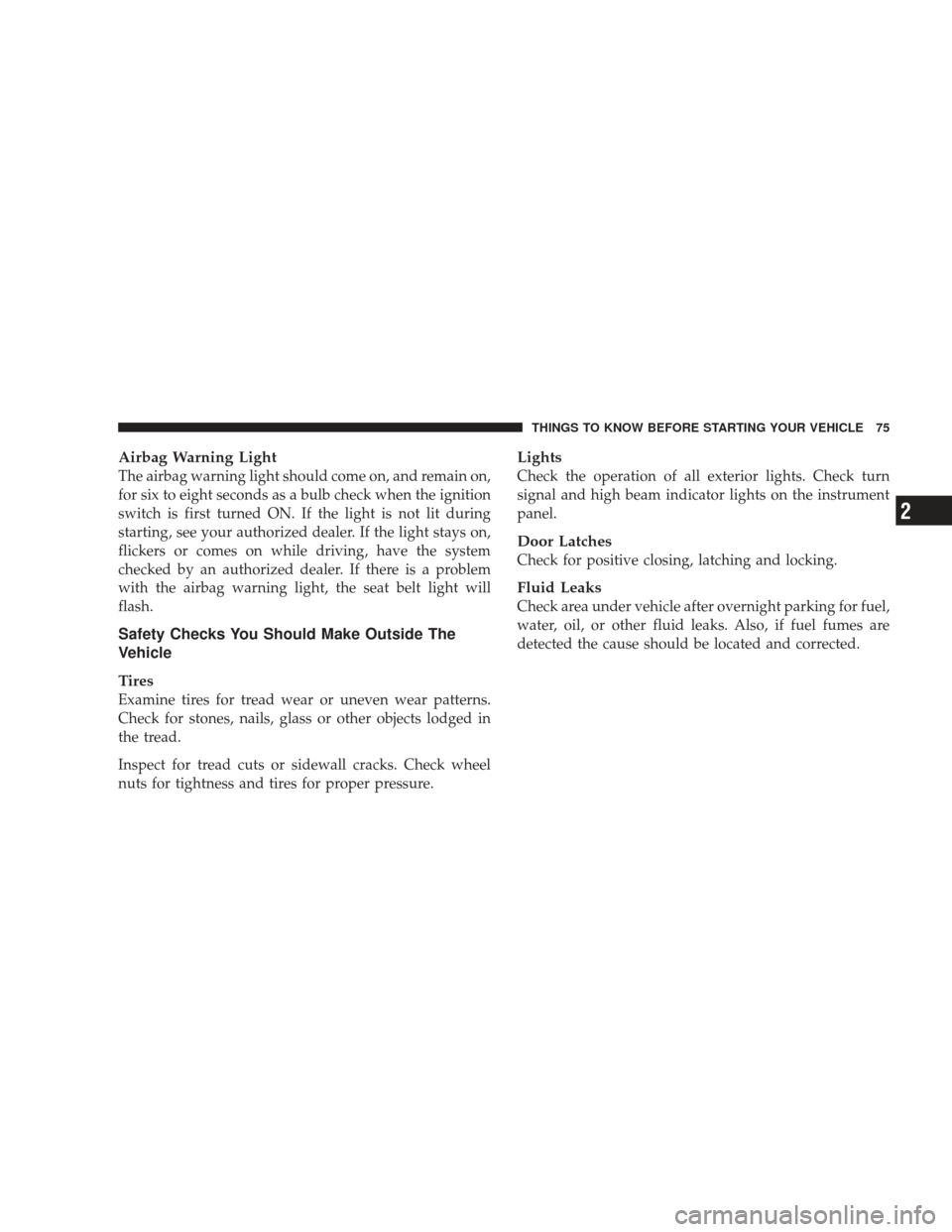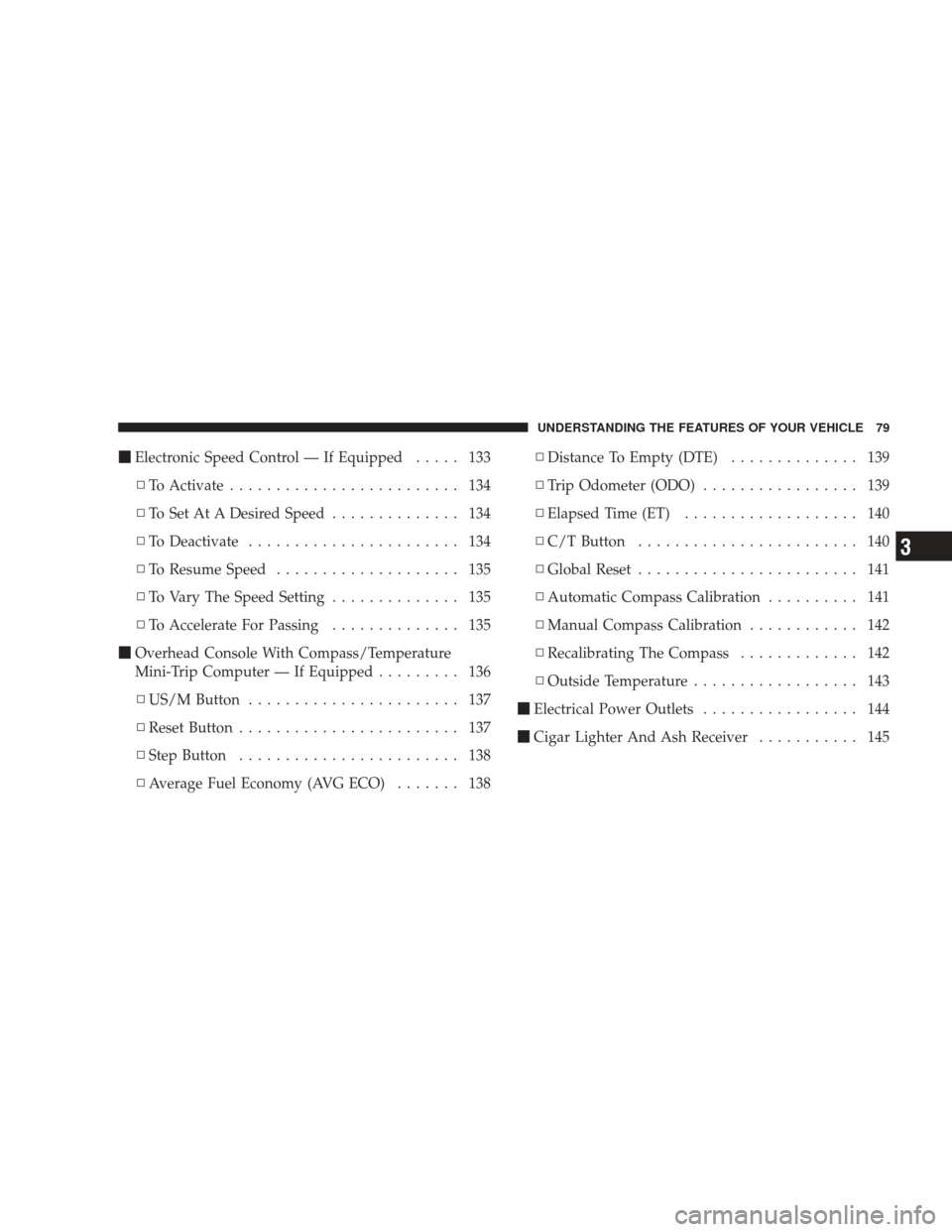Page 56 of 429

WARNING!
Whenever an airbag is turned off, even a lap/
shoulder belted passenger may hit their head, neck,
or chest on the dashboard (instrument panel) or
windshield in a crash. This may result in serious
injury or death.
To Shut Off the Passenger Airbag (Regular Cab Ve-
hicles Only) – If Equipped
Place the ignition key in the Passenger Airbag On/Off
Switch (if equipped), push the key in and turn clockwise,
and remove the key from the switch. This will shut off the
passenger airbag (if equipped). The OFF light near the
switch will illuminate when the ignition switch is turned
to the ON position. To Turn On the Passenger Airbag (Regular Cab Vehicles
Only) – If Equipped
Place the ignition key in the Passenger Airbag On/Off
Switch (If Equipped), push the key in and turn counter-
clockwise, and remove the key from the switch. This will
turn on the passenger airbag (if equipped). The OFF light
near the switch will be off when the ignition switch is
turned to the ON position.
If A Deployment Occurs
The airbag system is designed to deploy when the ORC
detects a moderate-to-severe frontal collision, and then
immediately to deflate.
NOTE:
A frontal collision that is not severe enough to
need airbag protection will not activate the system. This
does not mean something is wrong with the airbag
system.
54 THINGS TO KNOW BEFORE STARTING YOUR VEHICLE
Page 58 of 429

Enhanced Accident Response System
If the airbags deploy after an impact and the electrical
system remains functional, vehicles equipped with
power door locks will unlock automatically. In addition,
approximately 10 seconds after the vehicle has stopped
moving, the interior lights will light until the ignition
switch is turned off.
Maintaining Your Airbag Systems
WARNING!
•Modifications to any part of the airbag system
could cause it to fail when you need it. You could
be injured because the airbags are not there to
protect you. Do not modify the components or
wiring, including adding any kind of badges or
stickers to the steering wheel hub trim cover or the
upper right side of the instrument panel. Do not
modify the front bumper, vehicle body structure,
or frame.
•You need proper knee impact protection in a
collision. Do not mount or locate any aftermarket
equipment on or behind the knee bolster.
•It is dangerous to try to repair any part of the
airbag system yourself. Be sure to tell anyone who
works on your vehicle that it has airbags.
56 THINGS TO KNOW BEFORE STARTING YOUR VEHICLE
Page 59 of 429

NOTE:Perchlorate Material – special handling may apply:
Refer to www.dtsc.ca.gov/hazardouswaste/perchlorate.
Airbag Warning Light
You will want to have the airbags ready to
inflate for your protection in an impact. While
the airbag system is designed to be mainte-
nance free, if any of the following occurs, have
an authorized dealer service the system promptly:
•The Airbag Warning Light does not come on or flickers
during the six to eight seconds when the ignition
switch is first turned ON.
•The light remains on or flickers after the six to eight
second interval.
•The light flickers or comes on and remains on while
driving. NOTE:
If the speedometer, tachometer or any engine
related gauges are not working, the ORC may also be
disabled. The airbags may not be ready to inflate for your
protection. Promptly check the fuse block for blown
fuses. For proper location of airbag fuses, refer to “Fuses
(Integrated Power Module)” in Section 7. See your au-
thorized dealer if the fuse is good.
Event Data Recorder (EDR)
In the event of an accident, your vehicle is designed to
record up to approximately five seconds of specific
vehicle data parameters (see the following list) in an
event data recorder prior to the moment of airbag de-
ployment, or near deployment, and up to a quarter-
second of high-speed deceleration data during and/or
after airbag deployment. EDR data are ONLY recorded if
an airbag deploys, or nearly deploys, and are otherwise
unavailable.
THINGS TO KNOW BEFORE STARTING YOUR VEHICLE 57
2
Page 77 of 429

Airbag Warning Light
The airbag warning light should come on, and remain on,
for six to eight seconds as a bulb check when the ignition
switch is first turned ON. If the light is not lit during
starting, see your authorized dealer. If the light stays on,
flickers or comes on while driving, have the system
checked by an authorized dealer. If there is a problem
with the airbag warning light, the seat belt light will
flash.
Safety Checks You Should Make Outside The
Vehicle
Tires
Examine tires for tread wear or uneven wear patterns.
Check for stones, nails, glass or other objects lodged in
the tread.
Inspect for tread cuts or sidewall cracks. Check wheel
nuts for tightness and tires for proper pressure.
Lights
Check the operation of all exterior lights. Check turn
signal and high beam indicator lights on the instrument
panel.
Door Latches
Check for positive closing, latching and locking.
Fluid Leaks
Check area under vehicle after overnight parking for fuel,
water, oil, or other fluid leaks. Also, if fuel fumes are
detected the cause should be located and corrected.
THINGS TO KNOW BEFORE STARTING YOUR VEHICLE 75
2
Page 80 of 429

�Seats .............................. 114
▫ 40-20-40 Front Seat ................... 115
▫ Reclining Seats ...................... 116
▫ Adjustable Head Restraints ............. 117
▫ Manual Rotary Lumbar Support
Adjustment — If Equipped ............. 118
▫ Power Seats — If Equipped ............. 118
▫ Heated Seats — If Equipped ............ 120
� To Open And Close The Hood ............ 121
� Lights ............................. 123
▫ Interior Lights ...................... 123
▫ Battery Saver ....................... 124
▫ Headlight Delay ..................... 124 ▫
Headlights, Parking Lights And
Panel Lights ........................ 125
▫ Daytime Running Lights — If Equipped .... 126
▫ Lights-On Reminder .................. 126
▫ Fog Lights — If Equipped .............. 126
▫ Multifunction Lever .................. 126
� Windshield Wipers And Washers .......... 129
▫ Intermittent Wiper System .............. 129
▫ Windshield Washers .................. 130
� Tilt Steering Column ................... 130
� Driver Adjustable Pedals — If Equipped ..... 131
▫ Adjustment ........................ 132
78 UNDERSTANDING THE FEATURES OF YOUR VEHICLE
Page 81 of 429

�Electronic Speed Control — If Equipped ..... 133
▫ To Activate ......................... 134
▫ To Set At A Desired Speed .............. 134
▫ To Deactivate ....................... 134
▫ To Resume Speed .................... 135
▫ To Vary The Speed Setting .............. 135
▫ To Accelerate For Passing .............. 135
� Overhead Console With Compass/Temperature
Mini-Trip Computer — If Equipped ......... 136
▫ US/M Button ....................... 137
▫ Reset Button ........................ 137
▫ Step Button ........................ 138
▫ Average Fuel Economy (AVG ECO) ....... 138▫
Distance To Empty (DTE) .............. 139
▫ Trip Odometer (ODO) ................. 139
▫ Elapsed Time (ET) ................... 140
▫ C/T Button ........................ 140
▫ Global Reset ........................ 141
▫ Automatic Compass Calibration .......... 141
▫ Manual Compass Calibration ............ 142
▫ Recalibrating The Compass ............. 142
▫ Outside Temperature .................. 143
� Electrical Power Outlets ................. 144
� Cigar Lighter And Ash Receiver ........... 145
UNDERSTANDING THE FEATURES OF YOUR VEHICLE 79
3
Page 83 of 429
MIRRORS
Inside Day/Night Mirror
Headlight glare can be reduced by moving the small
control under the mirror to the night position (toward the
rear of the vehicle). The mirror should be adjusted while
set in the day position (toward the windshield). The
mirror should be adjusted to center on the view through
the rear window.
Adjusting Rearview Mirror
UNDERSTANDING THE FEATURES OF YOUR VEHICLE 81
3
Page 84 of 429
Automatic Dimming Mirror — If Equipped
This mirror automatically adjusts for headlight glare
from vehicles behind you. You can turn the feature on or
off by pressing the button at the base of the mirror. A light
in the button will illuminate to indicate when the dim-
ming feature is activated.CAUTION!
To avoid damage to the mirror during cleaning, never
spray any cleaning solution directly onto the mirror.
Apply the solution onto a clean cloth and wipe the
mirror clean.
Outside Mirrors
To receive maximum benefit, adjust the outside mirror(s)
to center on the adjacent lane of traffic with a slight
overlap of the view obtained on the inside mirror.
Automatic Dimming Mirror
82 UNDERSTANDING THE FEATURES OF YOUR VEHICLE